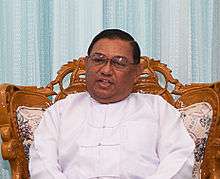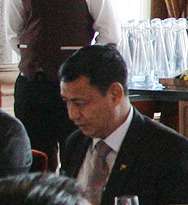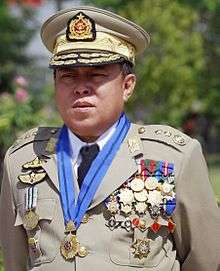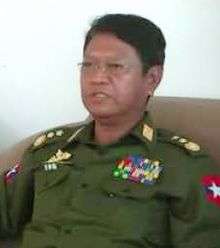Thein Sein's Cabinet
| Thein Sein Cabinet | |
|---|---|
|
cabinet of Myanmar | |
|
Head and Deputy Heads of the Government | |
| Date formed | 30 March 2011 |
| Date dissolved | 30 March 2016 |
| People and organisations | |
| Head of state | Thein Sein |
| Head of government | Thein Sein |
| Deputy head of government |
|
| Member party | USDP–Military |
| Opposition party | NLD |
| Opposition leader | Aung San Suu Kyi |
| History | |
| Election(s) | Myanmar general election, 2010 |
| Outgoing election | Myanmar general election, 2015 |
| Predecessor | Military Government |
| Successor | Htin Kyaw's Cabinet |
The cabinet of Thein Sein (Burmese: ဦးသိန်းစိန် အစိုးရ), headed by President Thein Sein, is the first democratically elected government of Myanmar after the military government. It took office on 30 March 2011 after the Myanmar general election, 2010 to 30 March 2016.
Cabinet
Cabinet resignations (August 2015)
On 12 August 2015, Minister Tin Naing Thein, Myat Hein, Khin Yi and Than Htay, who will be competing in the November 8 election had resigned, and Lt-Gen Wai Lwin and Lt-Gen Thet Naing Win had moved to their former military responsibilities, replaced by Lt-Gen Sein Win and Lt-Gen Kyaw Swe.[1] On 9 December, minister Ko Ko Oo died and Khin San Yi co-administrated both ministries.
July 2014–August 2015 Cabinet
Cabinet dismissal and resignations (June–July 2014)
On 19 June 2014, Hsan Sint was dismissed from the office of Minister of Religious Affairs and brought to court for corruption. He is the first Minister dismissed openly. He was succeeded by Soe Win, Deputy Minister for Religious Affairs and former Deputy Minister for Ministry of Information.[4] Minister for Information Aung Kyi and Minister for Health Pe Thet Khin were allowed to resign on 29 July 2014.[5] They are succeeded by Ye Htut and Than Aung, Deputy Ministers.[6]
Cabinet reshuffle (September 2012–February 2013)
On 4 September 2012, Pyidaungsu Hluttaw approved the government's reshuffle of ministries, increasing the number to 36, including six ministers located in the President's Office. The President approved the resignation of Zaw Min, Union Minister for Electric Power-1, and Khin Maung Myint, Union Minister for Construction. The President also approved the resignation of Union Auditor-General Lun Maung on 28 August. Thein Hteik, Union Minister for Mines, was appointed as Union Auditor-General, and Lt-Gen Wai Lwin of the Office of Commander-in-Chief (Army) as Union Defence Minister. Wai Lwin was replaced Lt-Gen Hla Min, who was reassigned to the military.[7] During the government's major cabinet reshuffle, nine ministers have been reassigned, mainly with four transferred to the President's Office and one, Aung Kyi, named as the new Minister for Information, replacing Kyaw Hsan, who was transferred to the Ministry of Cooperatives as minister. In the present reformation of the cabinet, Ministries of Electric Power No. 1 and 2 were combined into one as the Ministry of Electric Power, while the Ministry of Industrial Development was abolished.[8][9]
On 16 January 2013, Minister for Communications and Information Technology, Thein Tun and Minister for Religious Affairs, Thura Myint Maung abruptly resigned. Thein Tun was the first government minister known to have been investigated for corruption under the new government. San Sint, Speaker of Ayeyarwaddy Regional Hluttaw succeed Thura Myint Maung later. On 13 February 2013, former Commander-in-Chief of air force, General Myat Hein become minister for Communications and Information Technology.[3]
This appointments serve as a reminder that most ministers in the government are former officers who played a role in the previous military junta. Since taking office in 2011, the reformist president, who is himself a former general, has selected former senior military officers into government as it simply continues the flawed practices of past military rule, and given only a handful of posts to people without a military background.[10]
Inaugural Cabinet (March 2011)
The Cabinet was sworn in on 30 March 2011 at the Hluttaw complex in Naypyidaw, after being appointed by President Thein Sein.[11] Four ministers, namely of the Ministry of Defence, Ministry of Home Affairs, Ministry of Foreign Affairs and the Ministry of Border Affairs were nominated by Commander-in-Chief Than Shwe.[12] Two ministries, the Ministry of the President's Office and the Ministry of Industrial Development were created by the Hluttaw (Parliament) on 9 February 2011.[12]
The overwhelming majority of Ministers are Union Solidarity and Development Party members of parliament or military officers affiliated with the former State Peace and Development Council (SPDC), and four are civilians.[13] 12 have previously held ministerial posts, while another 7 have held deputy ministerial posts during the SPDC administration. 3 are former regional army commanders. On 10 August 2011, the cabinet was reshuffled, with Kyaw Swa Khaing, previously the Minister of Industry No. 1 (with Minister of Industry No. 2, Soe Thein, concurrently becoming head of the Ministry of Industry-1), appointed as co-Minister of the President's Office.[14]
| Ministry | Minister Name | Party | Notes |
|---|---|---|---|
| Ministry of Home Affairs | Ko Ko | Military | former SPDC Chief of the Bureau of Special Operations-3 |
| Ministry of Defence | Hla Min | Military | former SPDC Southern Command Commander |
| Ministry of Border Affairs | Thein Htay | Military | former SPDC Deputy Minister of Defence, Vice-Chief of Ordinance, and Chief of Military Ordinance |
| Ministry of Industrial Development | |||
| Ministry of Foreign Affairs | Wunna Maung Lwin | Military | former Ambassador to the United Nations (2007-2011) |
| Ministry of Information | Kyaw Hsan | Military | former SPDC Minister of Information and Brigadier General |
| Ministry of Culture | |||
| Ministry of Agriculture and Irrigation | Myint Hlaing | USDP | former SPDC Northeast Command Commander and Air Force Chief of Staff |
| Ministry of Commerce | Wunna Kyawhtin Win Myint | USDP | former President of Union of the Myanmar Federation of Chambers of Commerce and Industry |
| Ministry of Construction | Khin Maung Myint | USDP | former SPDC Minister of Electric Power-2, Minister of Construction and Major General |
| Ministry of Hotels and Tourism | Tint Hsan | USDP | |
| Ministry of Sports | |||
| Ministry of Communications, Posts and Telegraphs | Thein Tun | USDP | former SPDC Deputy Minister for Communications, Posts and Telegraphs and Major General |
| Ministry of Finance and Revenue | Hla Tun | USDP | former SPDC Minister of Finance and Revenue and Major General |
| Ministry of Mines | Thein Htaik | USDP | former Lieutenant General |
| Ministry of Transport | Nyan Tun Aung | USDP | former SPDC Deputy Minister of Transport |
| Ministry of National Planning and Economic Development | Tin Naing Thein | USDP | former SPDC Minister of Livestock and Fisheries and Brigadier General |
| Ministry of Livestock and Fisheries | |||
| Ministry of Environmental Conservation and Forestry | Win Tun | Military | former SPDC Minister of Forestry Director |
| Ministry of Labor | Aung Kyi | USDP | former SPDC Minister of Labor |
| Ministry of Social Welfare, Relief and Resettlement | |||
| Ministry of Cooperatives | Ohn Myint | USDP | former SPDC Bureau of Special Operations-6, Northern Command Commander and Lieutenant General |
| Ministry of Industry | Soe Thein | USDP | former SPDC Minister of Industry-2 and Lieutenant-General |
| Ministry of Energy | Than Htay | USDP | former SPDC Deputy Minister of Energy |
| Ministry of Rail Transportation | Aung Min | USDP | former SPDC Minister of Rail Transportation |
| Ministry of Education | Mya Aye | – | former rector of the Mandalay University |
| Ministry of Religious Affairs | Myint Maung | USDP | former SPDC Minister of Religious Affairs |
| Ministry of Immigration and Population | Khin Yi | Military | former SPDC Brigadier General, Chief of National Police, and SPDC Deputy Minister of Home Affairs |
| Ministry of Electric Power-1 | Zaw Min | USDP | former SPDC Minister of Electric Power-1 and Colonel |
| Ministry of Electric Power-2 | Khin Maung Soe | – | former Chairman of the Yangon City Electric Power Supply Board |
| Ministry of Science and Technology | Aye Myint | USDP | former SPDC Minister of Sports, Deputy Minister of Defence, and Major General |
| Ministry of President's Office | Soe Maung Thein Nyunt Kyaw Swa Khaing | USDP USDP USDP | former Lieutenant General, Judge Advocate General, and Military Judge General former SPDC Minister of Progress of Border Areas, National Races and Development Affairs and Mayor of Naypyidaw (2006-2011) SPDC Deputy Minister of Industry-2 and General |
| Ministry of Health | Pe Thet Khin | – | Former rector at University of Medicine 1, Yangon |
Heads and Ministers
|
Distant Tasks Carried Out



2011
- 30 September (Myitsone Dam) – On 30 September 2011, in an address to the parliament, President Thein Sein announced that the Myitsone Dam project would be halted during the term of his government.[16]
- U.S Secretary, Hillary Clinton Visit (1 December) – The United State Secretary, Hillary Clinton visited to the Naypyidaw and met with Cabinet's head Thein Sein. She is the first state secretary visited to Myanmar in fifty years.
2012
- Myanmar by-elections, 2012 (1 April) – The UEC held the by-election in April. This make the opponent leader, Aung San Su Kyi and her party members able to the Parliament .Aung San Su Kyi became the representative for Myanmar lower parliament, Pyithu Hluttaw from Kawhmu Township.
- Obama First Visit (19 November) – United States President Barack Obama visited to Yangon for one day. He met with Cabinet's head Thein Sein at Yangon Region Parliament. He became the first US president to visit Myanmar.
2013
- 27th SEA Games – The Cabinet held the 27th SEA Games after 44 years later the last hosted in Yangon in 1969 as 5th SEAP Games.The game was hosted in Naypyidaw, Yangon, Mandalay and Ngwe Saung. The games were officially opened on 11 December 2013 and closed on 22 December 2013 by the VP Nyan Tun. The opening and closing ceremonies were held with the wonderful exploration of fireworks and many volunteers. It can be said the greatest event in Myanmar history. But, the critics said that the million dollar of money spent on the ceremonies are only wasted.
2014
- 2014 ASEAN Para Games – The ASEAN Para Games was held in January 2014 after the 27th SEA Games. The games were officially opened on January 14 2014 and closed on 20 January by VP Sai Mauk Kham.
- 9th EAS Summit (12-13 November) – The cabinet hosted the Ninth East Asia Summit.
- ASEAN Chairman and ASEAN Summits – The head of the cabinet, Thein Sein chaired the 24th and 25th ASEAN Summits. 24th Summit was held on 4-5 May and the 25th Summit was on 12-13 November. The ASEAN leaders adopted the Nay Pyi Taw Declaration on the ASEAN Community’s Post-2015 Vision and the Declaration on Strengthening the ASEAN Secretariat and Reviewing the ASEAN Organs and the ASEAN Joint Statement on Climate Change at the 25th ASEAN Summit.
See also
References
- ↑ "Top ministers resign". Eleven. 13 August 2015. Retrieved 13 August 2015.
- 1 2 https://web.archive.org/web/20121113170332/http://www.myanmar.com/newspaper/nlm/Feb14_02.html. Archived from the original on 13 November 2012. Retrieved 14 February 2013. Missing or empty
|title=(help) - 1 2 3 Latt, Win Ko Ko (11 February 2013). "Air Force boss to take over telecoms". The Myanmar Times. Retrieved 13 February 2013.
- ↑ "MPs agree on religious affairs minister replacement". www.mmtimes.com. Ei Ei Toe Lwin. Retrieved 4 July 2014.
- ↑ "Myanmar information and health ministers step down | Mail Online". Dailymail.co.uk. Associated Press. Retrieved 29 July 2014.
- ↑ "Who is Ye Htut?". The Nation. 31 July 2014. Retrieved 1 August 2014.
- ↑ https://web.archive.org/web/20120913060230/http://www.elevenmyanmar.com/politics/627-thein-sein-proposes-to-scrap-ministries. Archived from the original on 13 September 2012. Retrieved 6 September 2012. Missing or empty
|title=(help) - ↑ "BBC News – Burma president announces cabinet reshuffle". Bbc.co.uk. 27 August 2012. Retrieved 13 February 2014.
- ↑ https://web.archive.org/web/20120906062313/http://mizzima.com/news/inside-burma/7933-parliament-approves-ministry-realignments.html. Archived from the original on 6 September 2012. Retrieved 6 September 2012. Missing or empty
|title=(help) - ↑ Nyein, Nyein (14 February 2013). "Former Generals to Run Burma's Telecoms, Border Affairs Ministries". The Irrawaddy. Retrieved 15 February 2013.
- ↑ Wai Moe (29 March 2011). "Thein Sein and Cabinet Scheduled to be Sworn in on Wednesday". The Irrawaddy. Retrieved 19 August 2011.
- 1 2 Ahunt Phone Myat (9 February 2011). "Major government overhaul underway". Democratic Voice of Burma. Retrieved 19 August 2011.
- ↑ "Correction: Myanmar President Forms 30-member Cabinet". RTT News. 9 February 2011. Retrieved 19 August 2011.
- ↑ Thein Sein (10 August 2011). "Union Minister Reshuffled" (PDF). New Light of Myanmar. Retrieved 21 August 2011.
- ↑ "REGIME WATCH > CABINET". Alternative Asean Network on Burma. 10 August 2011. Retrieved 19 August 2011.
- ↑ "Burma Dam".
.jpg)





.jpg)





.jpg)